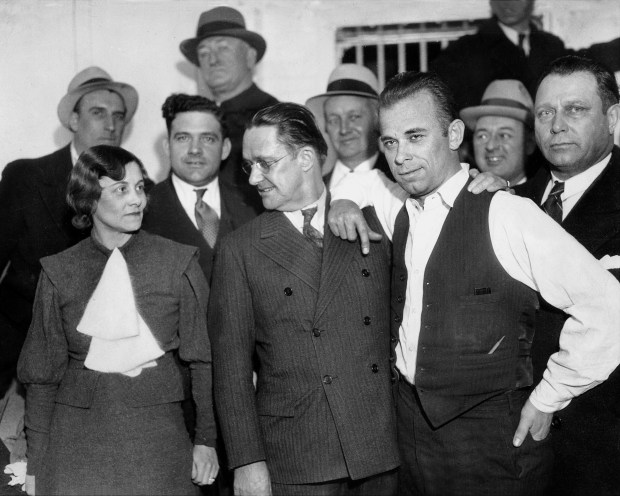For years, sightseeing buses have paused at an alley next to the Biograph Theater on Lincoln Avenue. Compared to other stops, there is not much to see. Passengers might wonder where they are and why.
“Look, at the mouth of the alley,” their driver/guide announces. “That’s where John Dillinger was killed on July 22, 1934. He and a pair of lady friends had just seen the movie ‘Manhattan Melodrama.’ ”
“Was one the woman in red?” a sightseer excitedly responds.
Dillinger was the archetype of a peculiarly American folk hero: An outlaw famed for his or her crimes. Contemporaries included fellow bank robbers Bonnie and Clyde, predecessors were often “cowboys” like Billy the Kid.
But only Dillinger had the magnetism that made elected officials vie for a share of his tainted celebrity. The Chicago Crime Commission’s president was outraged when an Indiana prosecutor posed for a newspaper photographer with his arm around Dillinger earlier in 1934 while the hoodlum awaited trial for killing a police officer during a bank robbery.
“Perhaps it isn’t unethical but it is certain that such familiarity breeds contempt for law enforcement in the minds of criminals,” Frank Loesch told the Tribune.
For her role in helping the feds nail Dillinger, Ana Cumpanaș, a Romanian-born brothel keeper who went by the name Anna Sage, is known as the “Woman in Red” by devotees of the dark side of Chicago lore.
Sage was cooperating with the feds, and told authorities she’d wear a distinctive color on the night of the movie outing so they’d be able to know the guy with her was Dillinger. It’s often reported as red, but it may have been orange. At any rate, the authorities in return promised to try to have her impending deportation squashed.
They cut a deal because Dillinger was shredding the FBI’s image as untouchable super-cops. The cops claimed he was a master of disguise. FBI Director J. Edgar Hoover said that Dillinger “sometimes dressed as a nun, so that he could scout around the intended scene of a robbery or raid,” the Tribune reported.
“Fear that Dillinger will stage one of his well-known bank robberies is costing bankers of Illinois and other central states more than $1,000 a day as pay for extra guards,” the Tribune reported in March 1934.
Dillinger had recently escaped from the Crown Point, Indiana, jail. “That’s what might be expected of having a woman sheriff,” Loesch said of the escape.
Lake County (Indiana) Sheriff Lillian Holley, fired back, declaring to the Tribune that “I’m not a sissy.” She set out to find Dillinger, promising: “If I ever see John Dillinger I’ll shoot him dead with my own pistol.”
While accounts of his jail escape vary, the Tribune reported that Dillinger used a wooden gun he had carved with a safety razor and painted black with shoe polish. During his escape he encountered the warden’s wife and her mother. The faux gun convinced them to do as he said.
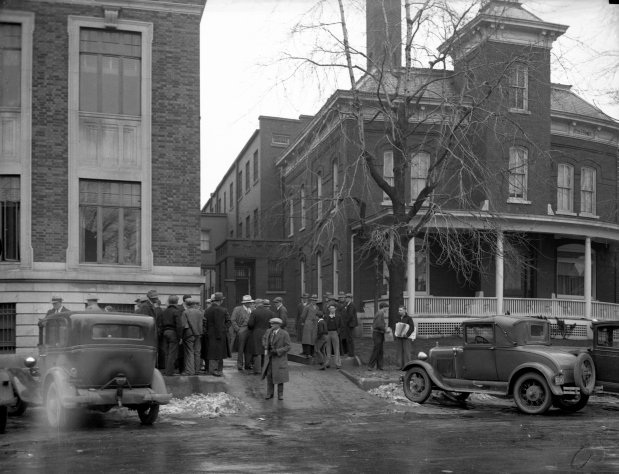
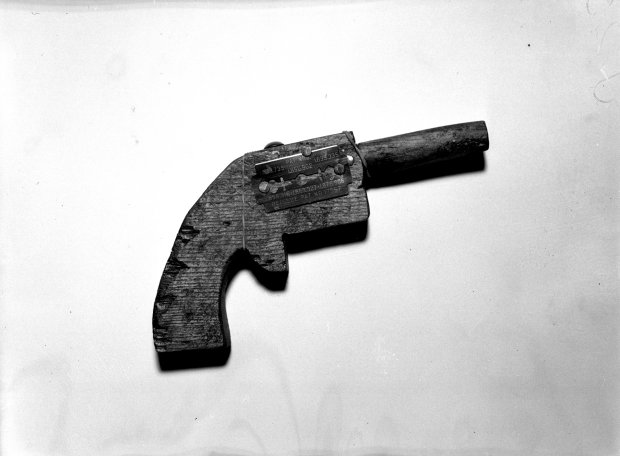
Dillinger escaped in the sheriff’s car, which he commandeered after asking men in a garage near the jail, “What’s the fastest car in the joint?”
Earnest Blunk, the deputy sheriff, was forced into the getaway car. Dillinger was singing “The Last Roundup.” One line stuck in Blunk’s memory:
“Git away, lil’ doggy git away,”
Dillinger’s crime spree came at a time when the public often had easy access to alleged criminals in custody. At some point, Dillinger was put in front of a group that asked questions about his craft with the reverence of fledgling artists in a master class.
“Someone asked Dillinger how long it took him to clean out a bank,” the Tribune reported of the scene in an Indiana jail. “Oh, about a minute and 40 seconds,” he replied.
He was fiercely protective of his image as “Public Enemy No. 1.”
“I’ll be the laughing stock of the country,” he cried when arrested in Tucson, Arizona, prior to being shipped to the Crown Point jail to stand trial. “How could a hick town police force ever suspect me?”

Dillinger’s life of crime started early. He apprenticed himself to Edward Singleton, an older unsavory character, and the two robbed an elderly grocer. His father advised him to cop a plea and implicate Singleton in return for a light sentence. Instead, the judge gave Dillinger 10 to 20 years. Singleton served two years.
In May 1933, Dillinger was paroled. He immediately started robbing banks but before long he was captured and tossed into a jail cell in Lima, Ohio. That October, a gang of confederates helped bust him out. Posing as Indiana deputies, they were asked to see their credentials. “These are our credentials,” they said, flashing guns.
While Dillinger continued his life of crime, East Chicago police Sgt. Martin Zarkovich was furloughed to search for the hoodlum, who had killed his partner while robbing an East Chicago bank. Zarkovich turned to a hoodlum whose ex-girlfriend had become Dillinger’s girlfriend. Jealousy induced the hood to talk to Melvin Purvis, the FBI agent hunting Dillinger, and a trap was set.
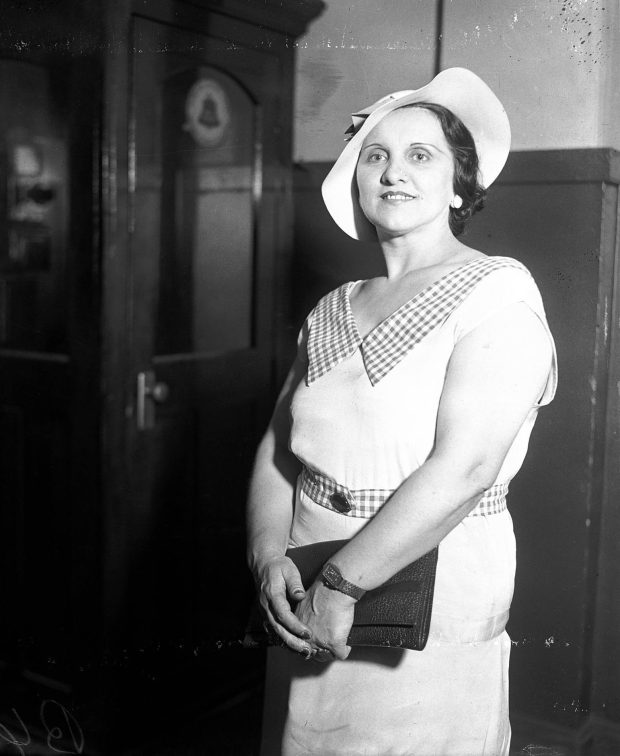
Anna Sage, nicknamed the “Woman in Red,” at the Sheffield Avenue police station in July 1934. Sage had been with John Dillinger when he was shot and killed by FBI agents outside the Biograph Theater in Chicago on July 22, 1934. (Chicago Tribune historical photo)
Anna Sage proved a crucial link. On July 4, 1934, Dillinger moved into Sage’s apartment at 2420 Halsted St. On July 22, she slipped out to phone an update to the feds. She reported that she, Dillinger, and his girlfriend were going to the Biograph Theater.
As the trio left the movie house, the agents approached Dillinger.
“I ran downstairs when the shooting started,” Ed Garber who was in an apartment above the alley, told the Tribune. “As I reached the plate glass door to the street two agents pushed me back inside and told me to stay there.”
Mrs. Pearl Doss, who as a child she lived near Dillinger in Indiana, was visiting a sister in Chicago and happened to be walking along Lincoln Avenue when the FBI shot her onetime neighbor. cq comment=”” ]
“As he slumped to the ground, the thought flashed through my mind that his face resembled Dillinger’s,” Doss told the Tribune. “I heard him utter: ‘They’ve got me, at last’.”
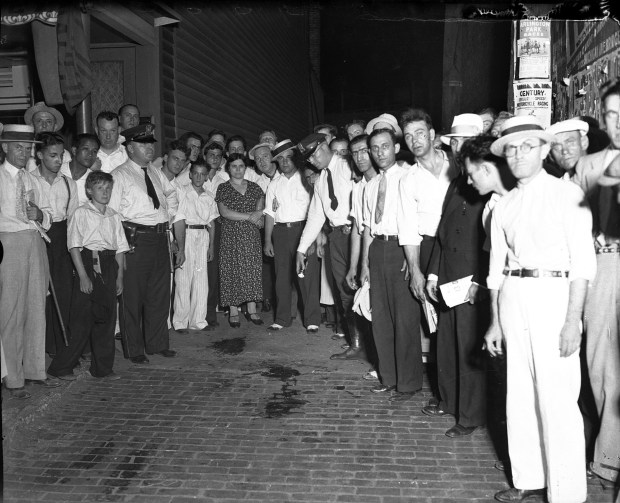
A crowd gathers around the blood stain from John Dillinger in the alley behind the Biograph Theater in Chicago in 1934. (Chicago Tribune historical photo)
People stuck their handkerchiefs in the pool of blood where Dillinger was shot. There was a ghoulish encore at the morgue.
“At every available window and door crushed groups of men and women who hoped to get a glimpse of America’s most famous outlaw — dead,” the Tribune reported.
Afterward, Dillinger’s father took his son’s corpse to Indianapolis and buried him in the Crown Hill Cemetery.
The gravestone had to be replaced three times. Die-hard fans repeatedly chipped off pieces.
Have an idea for Vintage Chicago Tribune? Share it with Ron Grossman and Marianne Mather at rgrossman@chicagotribune.com and mmather@chicagotribune.com


